Content
Phlox Cleopatra is a spectacular hybrid, famous for its voluminous flowers. Russian gardeners got acquainted with this novelty of Dutch selection quite recently, but have already managed to appreciate its amazing beauty.
Description of Paniculate Phlox Cleopatra
The fragile erect stems of this perennial form a bush 60–80 cm high, but the formation of massive peduncles leads to the fact that the branches can bend downward. It is recommended to use additional supports or tie the inflorescences. The width of the bush is on average 40–45 cm. Cleopatra grows rather quickly, when pinching the tops of the shoots it branches well.
The leaves are arranged oppositely on the stem. The leaf plate is bright green, smooth, regular in shape, with a sharpness at the ends. Peduncles of phlox paniculata Cleopatra are straight, smooth, even.
The variety belongs to light-loving crops, but needs protection from direct sunlight. Cleopatra tolerates partial shade well.
At the end of the season, the aerial part dies off, and the root system goes into a dormant state. Even severe frosts will not harm the Cleopatra variety, since its distinguishing feature is its ability to withstand frosts down to -30 ° C.
Due to the characteristics of the variety, Cleopatra phlox can be grown throughout Russia.
Flowering features
Phlox Cleopatra blooms from July to October. The flowers are fragrant, incredibly beautiful, bright pink with a cherry or strawberry hue. Their elongated petals form a corolla in the shape of a five-pointed star, and a row of rudimentary petals add extra volume. The diameter of the flowers is about 4 cm, they are collected in dense panicles of 80–90 wide pyramidal shapes.
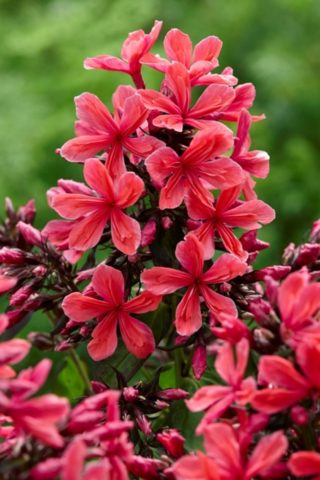
Due to the fact that not all flowers open at the same time, Cleopatra phlox is in a state of flowering for a long time
The condition of Cleopatra phlox directly depends on the growing conditions: moisture, looseness and fertility of the soil, as well as the amount of sunny color. It is known that bushes that have reached the age of 5–6 years begin to bloom worse, so it is recommended to renew such plants. Also, some gardeners advise leaving no more than 7 stems, so that the seedling will use all its energy not to build up green mass, but to form peduncles. Another technique for increasing the decorative effect of the bush is pinching the tops of the shoots. This stimulates the emergence of new branches, as a result of which the plant becomes much more lush.
Application in design
In group plantings, Cleopatra phlox goes well with plants that bloom purple or red. Against the background of snow-white cultures, the noble color of its corollas will look even more expressive.
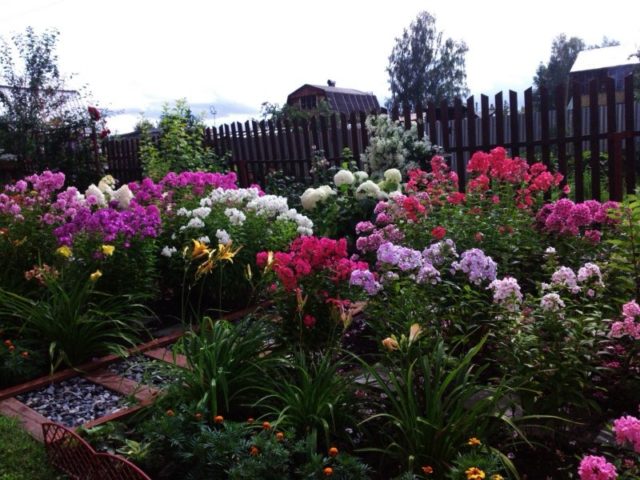
A very interesting effect can be achieved by experimenting with a combination of different plant varieties in floxaria
Most often, the Cleopatra variety is planted with other plants with the same flowering time, but it will perfectly fit into other ensembles. The color depth of the corollas will be emphasized by the combination with coniferous crops planted in the background. The perennial itself will become a winning background for low-growing horticultural crops.
When planning compositions, in addition to decorative characteristics, the requirements for growing conditions should be taken into account.

Phlox Cleopatra can be planted next to the cornflower, bellflower, yarrow, Japanese anemone or loosestrife
Avoid the neighborhood of a perennial with willow, birch, spruce and lilacs. The root system of these trees, like that of phlox, is close to the surface, which means it will take the moisture and nutrients necessary for the flowers.
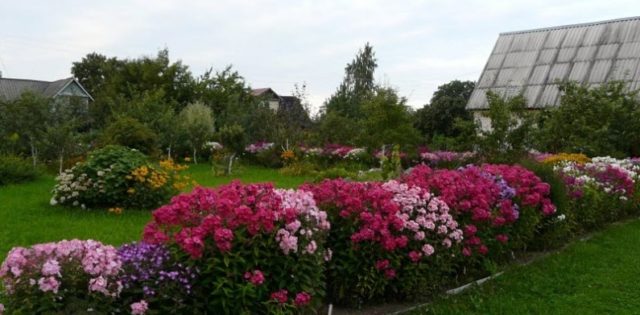
A living fence made of multicolored phlox looks bright and unusual
In the garden landscape, flowers are successfully grown near ponds, gazebos, benches, as a low curb along the paths.

You can plant them to decorate an alpine slide.
No less interesting is the Cleopatra phlox in single plantings - it is able to revive any corner of the garden. The bush will look especially elegant against the background of a bright green lawn or surrounded by ground cover flowers.
Due to its relatively small size, Cleopatra paniculata phlox can be planted both in open ground and in containers. The flowering plant looks great on loggias, balconies, potted terraces and flowerpots.
Reproduction methods
Phlox Cleopatra is propagated by dividing the bush, cuttings and sowing seeds. The most effective way to get young plants is to divide the mother bush, which has reached the age of five, into 2–3 stem divisions and plant them. Young plants grown in this way bloom in the same season.
Cutting is also considered an easy way to breed phlox, but seed propagation is a more laborious procedure, since the seeds must be stratified before sowing.
Landing rules
For planting phlox Cleopatra, sunny areas are most suitable, however, direct sunlight during the daytime can cause leaf burns. This culture grows well in partial shade. It is very important that the place is protected from strong winds, since the stems of Cleopatra phlox easily break during the period of abundant flowering.
The substrate should be fertile, well moistened, medium loamy soils are best suited.
Phlox Cleopatra can be planted in spring and autumn, but experienced gardeners recommend rooting the plants in the second half of April. The moisture retained in the soil after the snow melts promotes rapid root formation.
Landing is carried out according to the following algorithm:
- in the fall, the area for phlox is dug up and compost is added, the overly acidic soil is lime, and sand is added to heavy clay substrates;
- in the spring, before planting, they form a flower bed and make planting holes in it 25–35 cm deep, which are located at a distance of 40 cm from each other;
- compost and a mineral fertilizer complex are placed in the hole, then watered;
- planting material is placed in a hole and covered with earth.
Follow-up care
Like other varieties of phlox, the Cleopatra variety needs frequent watering. Lack of moisture negatively affects the decorative qualities of the plant. An adult phlox bush should have about 15 liters of water. Watering is carried out as the soil dries up strictly under the root with warm, settled water. So that a crust does not form on the surface, which impedes the access of air to the roots, after watering, the soil is shallowly loosened.
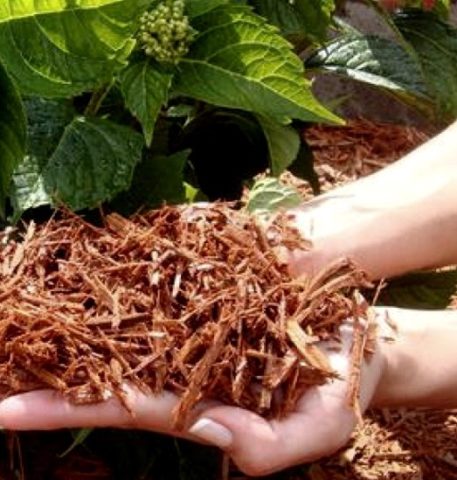
Mulching with natural materials will help to significantly facilitate the care of Cleopatra phlox.
This will preserve moisture in the soil, prevent weeds from growing and eliminate the need for loosening after each watering.
Top dressing of phloxes Cleopatra is done three times a season: at the beginning of the growing season, plants are fertilized with nitrogen-containing complexes, superphosphate and potassium fertilizers are added during the formation of buds and before winter.
Preparing for winter
The excellent winter hardiness of Cleopatra phlox in most cases allows you to do without sheltering plantings for the winter.
In preparation for winter, the aboveground part of the plant is cut off at a level of 2-3 cm from the soil surface, the cut material is burned, and the remains of the stems are sprinkled with copper sulfate.Also, before winter, superphosphate is introduced and the root system is well watered. If Cleopatra's seedlings need to be insulated, they are covered with spruce branches or mulched with peat.
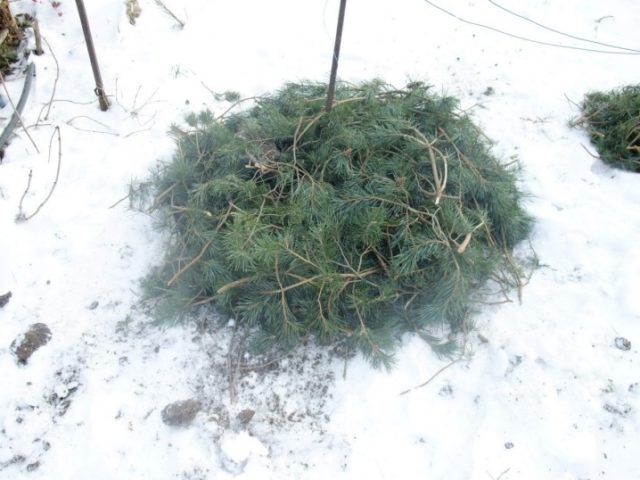
In the conditions of harsh snowless winters, it is recommended to cover the phlox root system
Pests and diseases
The greatest danger to phlox is represented by fungal pathologies: powdery mildew, leaf spot and some others. The phlox variety Cleopatra is highly immune to diseases of this group. If they still hit the planting, the crown is treated with soap, potassium permanganate or preparations containing copper.
Of the pests, nematodes - roundworms that damage roots, stems and leaves - parasitize most often on phlox. As a preventive measure, nasturtiums or marigolds can be planted in the vicinity of phlox, which repel the pest. The affected parts should be destroyed immediately.
Conclusion
Phlox Cleopatra is a variety, the main advantages of which are abundant lush flowering, disease resistance and unpretentiousness. More and more amateur flower growers and professional landscape designers use it to decorate gardens and other areas.








